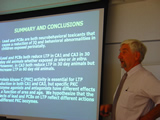

We have reported that prenatal exposure (0.1ppm) to Bisphenol A (BPA, a typical environmental endocrine disrupter) impairs the sexual differentiation of exploratory behavior and enhances depressive behavior (Fujimoto et al. 2005, 2006). In the present study, the effects of prenatal exposure to BPA on behavioral and neuronal responses to olfactory stimuli were examined. General motor activity and avoidance response to predator odor (fox) were measured in the odor avoidance test. Neuronal responses to various odors were examined in the medial amygdale using extracellular recording technique. The smell of fox predominantly suppressed locomotor activity and enhanced avoidance response in BPA exposure rats but not control rats. In the electrophysiological study, male medial amygdalar neurons showed selective excitatory responses to odors of predators. This type of neurons did not respond to plant odors. In contrast female amygdalar neurons did not show such selectivity in which excitatory neurons responding to predator odors also showed excitatory responses to plant odors. The sex difference in this neuronal response pattern was attenuated by prenatal exposure to BPA. These findings suggest that BPA impairs sexual differentiation of the medial amygdale affecting behavioral responses to the predator odors. Supported by COE program, Grants-in-Aid for Scientific Research and Health Sciences Research Grant.
UPThe present experiments were designed to elucidate the various homeostatic effects of direct orbitofrontal cortical administration of IL-1β. Short- and long-term food intakes (FI), water intakes and body temperature (BT) were measured before and after a bilateral microinjection of IL-1β (with or without paracetamol /IL-1β+P or P/ pretreatment) into the orbitofrontal cortex (OBF) of Wistar rats, and the effects were compared with those found in vehiculum-treated and i.p. injected IL-1β, IL-1β+P or control rats. In addition, blood glucose levels (BGLs), along a glucose tolerance test, and plasma concentrations of insulin, leptin, cholesterol, triglycerides and urate were determined in cytokine treated and control animals. Similar to consequences of the peripheral (i.p.) administrations, direct OBF microinjection of IL-1β remarkably reduced short-term food intake in food deprived animals. In the long-term FI, however, there was no significant difference among the groups. Orbitofrontal cortical cytokine microinjection, similar to the i.p. administration, was followed also by a significant raise in BT. Pretreatment with P failed to influence the anorexigenic and hyperthermic effects of the centrally administered IL-1β. The sugar load led to a diabetes-like prolonged elevation of BGL in the cytokine treated rats. Following cytokine microinjection, plasma levels of insulin and that of triglycerides were found decreased, whereas that of uric acid increased. In extracellular single unit recording studies, using the multibarreled microelectrophoretic technique, high proportion of OBF neurons were shown to change their firing rate in response to the microelectrophoretically administered cytokine. An overwhelming majority of these IL-1β sensitive neurons were also responsive to microelectrophoretically applied D-glucose, i.e., proved to be the elements of the central glucose-monitoring neural network (GMNN). The present findings confirm that neocortically organized IL-1â└ mediated adaptive reactions through the orbitofrontal cortical GMNN play important roles in the maintenance of body homeostasis.
UP
Exposures to lead, methyl mercury and polychlorinated biphenyl (PCBs) are known to reduce the ability to learn and remember. Lead is the best studied of these agents, but the effects of the others appear to be similar. Upon prenatal or early life exposure all appear to reduce IQ by some 5-7 IQ points, and it is likely that these effects are irreversible. Thus these compounds act to simply shift to the left the IQ distribution curve, affecting equally individuals who would otherwise be very bright as well as those who would not be. While these actions have not been easy to detect in adults, except in a few situations of high occupational exposure, they have also been seen in aged adults. Some of the studies of very old adults have demonstrated that lead and PCBs have specific detrimental effects on learning and memory without decrements of other nervous system functions, such as visual perception. The mechanism(s) of these actions is not known. Lead and PCBs reduce long-term potentiation, an electrical response that can be studied in animal preparations and which appears to be one component of learning. In children these contaminates also reduce attention span, which may in turn affect learning.



1-Bromopropane (1-BP) has been widely used for a solvent as a substitute of chlorofluorocarbons. Recently, it was reported that three female workers who used 1-BP as a solvent in a cushion company showed abnormal neurological symptoms or signs in the CNS. Occupational Exposure Limit for 1-BP has not been decided in Japan, though 10 ppm was recommended in USA. In the animal studies, effects on the reproductive system and the peripheral nervous system have been reported.ü@We have reported that repetitive inhalation of 1-BP caused disinhibition in the hippocampal formation resulting to convulsive behaviors (JOH 2000, 2002; Neuroscience 2004). In acute effects of 1-BP using xenopus oocytes expressed GABAAR and using rat hippocampal slices, GABA-mediated inhibition was enhanced in the both system at dose-dependent manner. GABA system has been known to involve with brain development, it is necessary to clarify the effects of prenatal exposure to 1-BP on brain development. In this seminar, I would like to introduce our results obtained from acute, repetitive and prenatal exposures to 1-BP, and discuss a long bridge from acute effects to the brain development.
UP| [UP] - [2002] - [2003] - [2004] - [2005] - [2006] |
Neuroscience Seminar Series in Hibikino © 2002-2005 by Katsumi Tateno Last Update: Jan 5, 2006 |